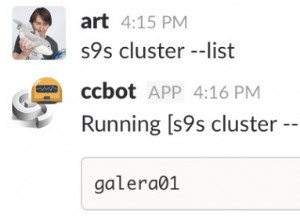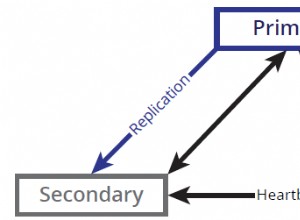Về cơ bản, bạn muốn bulkWrite()
, có thể lấy mảng đối tượng đầu vào và sử dụng nó để tạo một "loạt" yêu cầu cập nhật các tài liệu phù hợp.
Giả sử mảng tài liệu đang được gửi trong req.body.updates , sau đó bạn sẽ có một cái gì đó giống như
const Model = require('../models/model');
router.post('/update', (req,res) => {
Model.bulkWrite(
req.body.updates.map(({ slno, name }) =>
({
updateOne: {
filter: { slno },
update: { $set: { name } }
}
})
)
})
.then(result => {
// maybe do something with the WriteResult
res.send("ok"); // or whatever response
})
.catch(e => {
// do something with any error
})
})
Thao tác này sẽ gửi một yêu cầu với đầu vào là:
bulkWrite([
{ updateOne: { filter: { slno: 1 }, update: { '$set': { name: 'Item 3' } } } },
{ updateOne: { filter: { slno: 2 }, update: { '$set': { name: 'Item 1' } } } },
{ updateOne: { filter: { slno: 3 }, update: { '$set': { name: 'Item 2' } } } } ]
)
Điều này thực hiện hiệu quả tất cả các cập nhật trong một yêu cầu duy nhất tới máy chủ với một phản hồi duy nhất.
Cũng xem tài liệu MongoDB cốt lõi trên bulkWrite()
. Đó là tài liệu cho mongo phương thức shell, nhưng tất cả các tùy chọn và cú pháp hoàn toàn giống nhau trong hầu hết các trình điều khiển và đặc biệt là trong tất cả các trình điều khiển dựa trên JavaScript.
Như một minh chứng hoạt động đầy đủ về phương pháp được sử dụng với mongoose:
const { Schema } = mongoose = require('mongoose');
const uri = 'mongodb://localhost/test';
mongoose.Promise = global.Promise;
mongoose.set('debug',true);
const testSchema = new Schema({
slno: Number,
name: String
});
const Test = mongoose.model('Test', testSchema);
const log = data => console.log(JSON.stringify(data, undefined, 2));
const data = [1,2,3].map(n => ({ slno: n, name: `Item ${n}` }));
const request = [[1,3],[2,1],[3,2]]
.map(([slno, n]) => ({ slno, name: `Item ${n}` }));
mongoose.connect(uri)
.then(conn =>
Promise.all(Object.keys(conn.models).map( k => conn.models[k].remove()))
)
.then(() => Test.insertMany(data))
.then(() => Test.bulkWrite(
request.map(({ slno, name }) =>
({ updateOne: { filter: { slno }, update: { $set: { name } } } })
)
))
.then(result => log(result))
.then(() => Test.find())
.then(data => log(data))
.catch(e => console.error(e))
.then(() => mongoose.disconnect());
Hoặc cho các môi trường hiện đại hơn với async/await :
const { Schema } = mongoose = require('mongoose');
const uri = 'mongodb://localhost/test';
mongoose.Promise = global.Promise;
mongoose.set('debug',true);
const testSchema = new Schema({
slno: Number,
name: String
});
const Test = mongoose.model('Test', testSchema);
const log = data => console.log(JSON.stringify(data, undefined, 2));
const data = [1,2,3].map(n => ({ slno: n, name: `Item ${n}` }));
const request = [[1,3],[2,1],[3,2]]
.map(([slno,n]) => ({ slno, name: `Item ${n}` }));
(async function() {
try {
const conn = await mongoose.connect(uri)
await Promise.all(Object.entries(conn.models).map(([k,m]) => m.remove()));
await Test.insertMany(data);
let result = await Test.bulkWrite(
request.map(({ slno, name }) =>
({ updateOne: { filter: { slno }, update: { $set: { name } } } })
)
);
log(result);
let current = await Test.find();
log(current);
mongoose.disconnect();
} catch(e) {
console.error(e)
} finally {
process.exit()
}
})()
Quá trình tải dữ liệu ban đầu và sau đó cập nhật, hiển thị đối tượng phản hồi (được tuần tự hóa) và các mục kết quả trong bộ sưu tập sau khi bản cập nhật được xử lý:
Mongoose: tests.remove({}, {})
Mongoose: tests.insertMany([ { _id: 5b1b89348f3c9e1cdb500699, slno: 1, name: 'Item 1', __v: 0 }, { _id: 5b1b89348f3c9e1cdb50069a, slno: 2, name: 'Item 2', __v: 0 }, { _id: 5b1b89348f3c9e1cdb50069b, slno: 3, name: 'Item 3', __v: 0 } ], {})
Mongoose: tests.bulkWrite([ { updateOne: { filter: { slno: 1 }, update: { '$set': { name: 'Item 3' } } } }, { updateOne: { filter: { slno: 2 }, update: { '$set': { name: 'Item 1' } } } }, { updateOne: { filter: { slno: 3 }, update: { '$set': { name: 'Item 2' } } } } ], {})
{
"ok": 1,
"writeErrors": [],
"writeConcernErrors": [],
"insertedIds": [],
"nInserted": 0,
"nUpserted": 0,
"nMatched": 3,
"nModified": 3,
"nRemoved": 0,
"upserted": [],
"lastOp": {
"ts": "6564991738253934601",
"t": 20
}
}
Mongoose: tests.find({}, { fields: {} })
[
{
"_id": "5b1b89348f3c9e1cdb500699",
"slno": 1,
"name": "Item 3",
"__v": 0
},
{
"_id": "5b1b89348f3c9e1cdb50069a",
"slno": 2,
"name": "Item 1",
"__v": 0
},
{
"_id": "5b1b89348f3c9e1cdb50069b",
"slno": 3,
"name": "Item 2",
"__v": 0
}
]
Đó là sử dụng cú pháp tương thích với NodeJS v6.x




